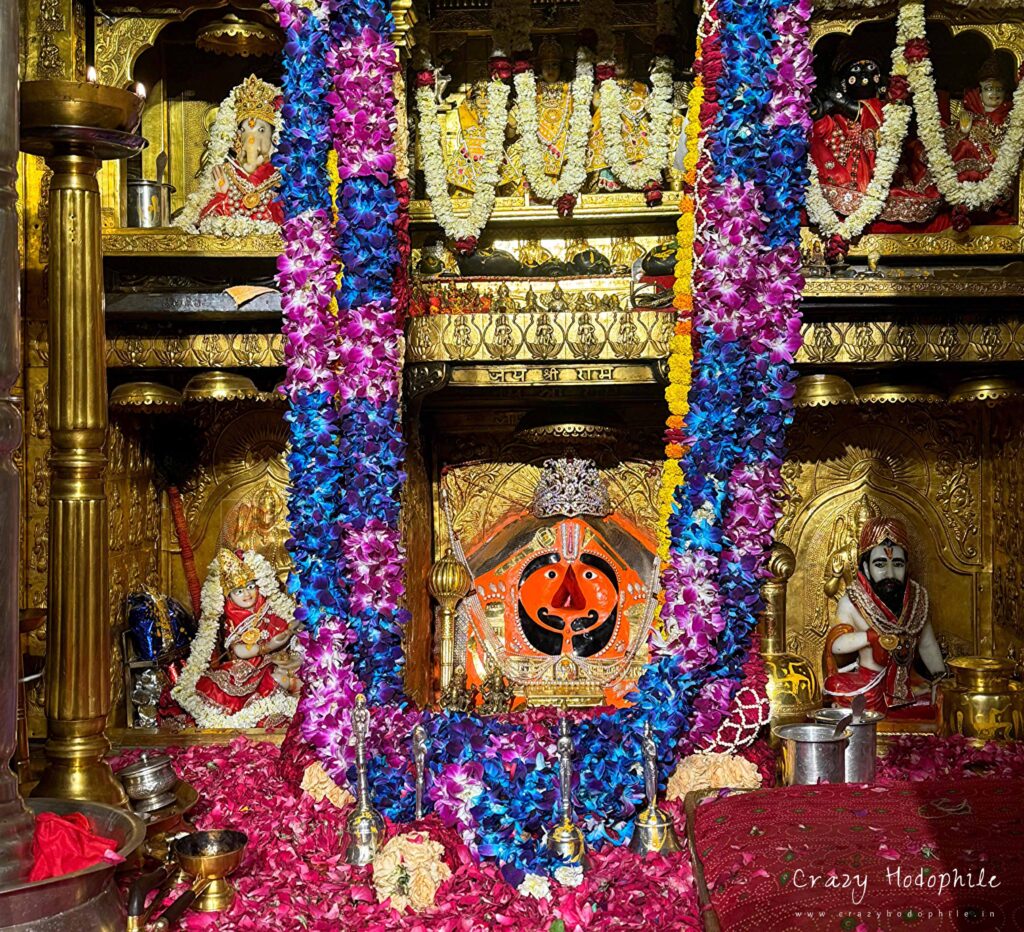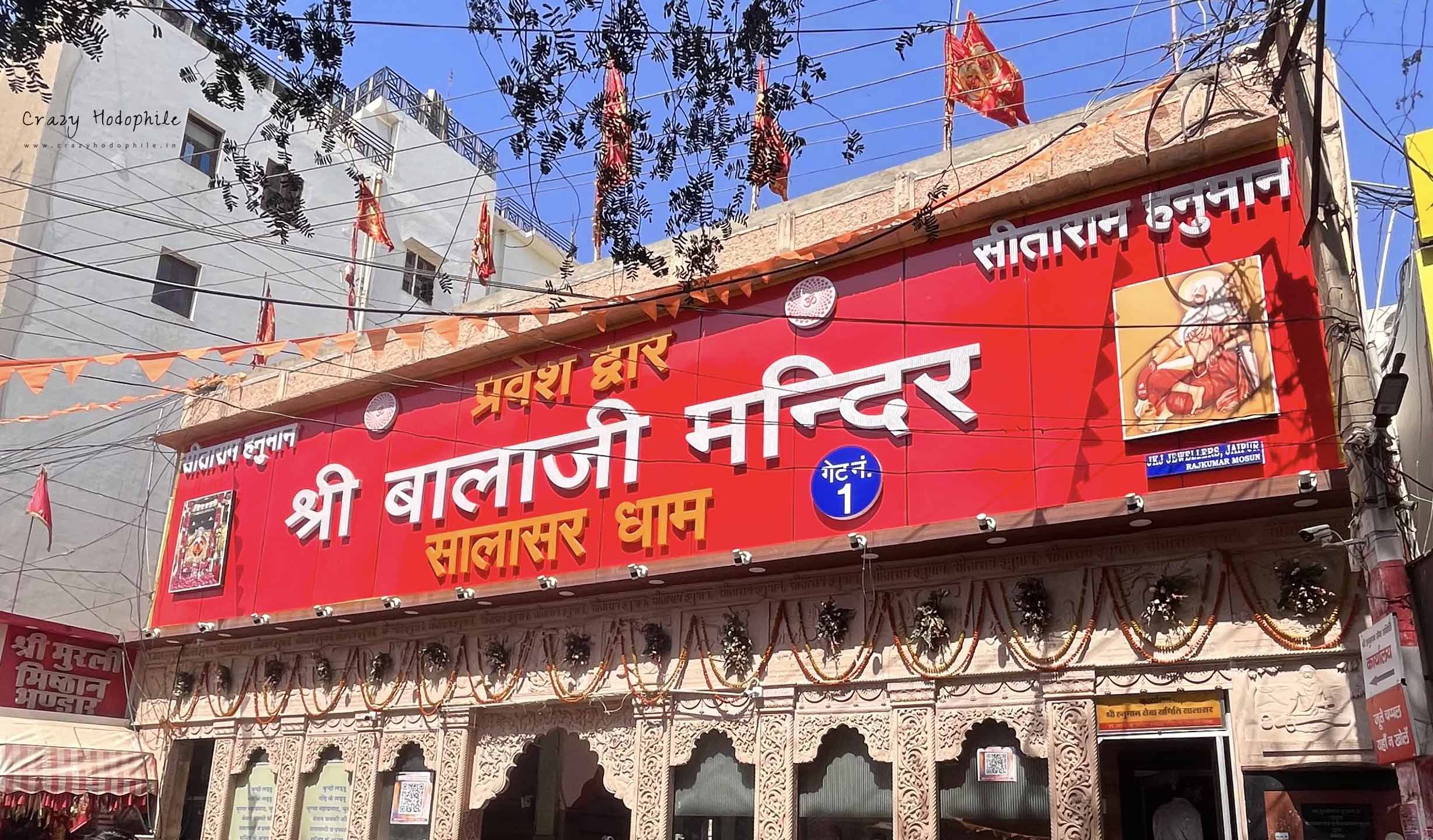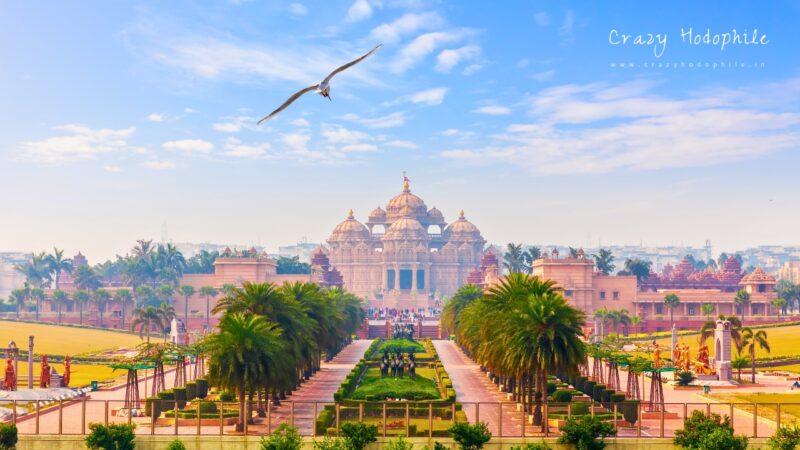The Mystique of Shree Salasar Balaji Dham Mandir, Rajasthan | Crazy Hodophile | 2025
Shree Salasar Balaji Dham Mandir is one of the most famous and ancient temples dedicated to Lord Hanuman, located in Salasar, a village in the Churu district of Rajasthan, India. The idol of Hanuman Ji in this temple is unique because it is depicted with a beard & mustache, unlike the usual clean-shaven representation. This feature sets it apart from other Hanuman temples and adds to its significance. Especially on Tuesdays and Saturdays, a large crowd of devotees is seen; even before sunrise in the morning, devotees are seen standing in long queues to have the darshan of Balaji. People travel here from far-off places to get a glimpse of Balaji and seek his blessings.

Table of Contents
History
The fascinating history of the Salasar Balaji Mandir traces back to the year 1754 AD when a farmer named Mohandas and his wife Kesar Devi found the idol of Hanuman ji while plowing the field.
The divine intervention did not end there. Mohandas later had a dream where Lord Balaji appeared to him, instructing him to enshrine the idol in a mandir at Salasar. Following this divine guidance, he took up the task of building a temple to house the idol. Before being installed in the Salasar mandir, the idol was enshrined at a place called Asota. There are various stories related to the history of the temple in which most of the people believe that in 1759 AD, that day was Tuesday and Navami (9th day) of Shukla Paksha (first fortnight) of Shravan month (July-August) when Mohandas built the temple (which is currently known as “Salasar Balaji Mandir), and entrusted the responsibility of serving the temple to his disciple, Shri Udairam, and his descendants. Then he withdrew from worldly affairs, entering into a state of deep meditation (samadhi).
Overview
The temple of Salasar Balaji is mainly made of stone and marble, like many Hindu temples in India. The main deity of the temple is Lord Hanuman, known as Balaji or Salasar Wale Balaji, the part of the temple where Balaji is enshrined is completely adorned in gold and silver. Apart from Lord Hanuman, the temple also has idols of other deities, such as Lord Rama, Goddess Sita, Lord Lakshman, and Lord Krishna.
There is also an Agni Kund (fire pit) in the temple courtyard, it is believed that the Agni (holy fire) in this Kund (pit) has been burning continuously since the temple was established, symbolizing the eternal presence and blessings of Lord Hanuman. Devotees first circumambulate around the Agni Kund and seek blessings. It is believed that the fire of Agni Kund has healing properties and can help in curing diseases and fulfilling desires. While leaving, the devotees take with them the sacred ashes (Vibhuti / Bhasma) of the fire pit, believing that it brings good fortune and prosperity. The Salasar Balaji Temple holds a special place in the hearts of devotees due to a unique belief, those who pray here with sincere hearts and unwavering faith, their wishes are fulfilled by Balaji and prosperity comes into their lives. In the Sanatan Dharma, Lord Hanuman is believed to be ever-present, transcending time itself.
A particularly famous verse from the Hanuman Chalisa resonates deeply with worshippers: “बल बुद्धि विद्या देहु मोहि हरहु कलेस विकार।,” which implores Hanuman Ji to grant strength, wisdom, and knowledge while relieving one of all troubles.
Hanuman Jayanti Celebration
Rich in history and spirituality, Salasar Balaji Temple is not only a place of worship but also a vibrant center of festivals. The most prominent festival here occurs during Hanuman Jayanti, the birthday of Lord Hanuman, which falls on the full moon day of the Hindu month of Chaitra. The temple is decorated with vibrant decorations and illuminated by the glow of countless lamps creating an atmosphere charged with devotion and spirituality. On this occasion, a large number of devotees come here chanting the name of Ram in devotion. The festival is marked by elaborate rituals, including recitation of Hanuman Chalisa, offering of churma (prasad) dedicated to Lord Hanuman, special prayers, and bhajan-kirtans.
Fair Details
Every year two fairs are organized near the temple premises:
- Chaitra Purnima Fair: This fair is organized during Hanuman Jayanti in the Chaitra month of the Hindu calendar, culminating on the full moon day known as Chaitra Purnima. This fair is one of the most important events of the temple, attracting a large number of devotees who come to seek the blessings of Lord Hanuman. The fair usually lasts for a few days and features various cultural activities, religious rituals, bhandaras, and a lively atmosphere.
- Sharad Purnima Fair: Another important fair at Salasar Balaji Temple is organized during the Ashwin month (September–October) of the Hindu calendar, which coincides with the full moon day known as Ashwin Purnima. This fair, like Chaitra, is a major attraction for devotees and visitors. It also includes a variety of cultural and religious activities, making it a vibrant and colorful event.
Aarti (Ceremony of Light) Timings
Every day, the Salasar Balaji Mandir resonates with the sacred sounds of aartis, creating a serene and spiritual atmosphere. The temple hosts three main aartis, each carrying its own significance and charm.
- Mangala Aarti – The day begins with the Mangala Aarti, at 5:30 in the morning.
- Sandhya Aarti – As the day progresses, the temple comes alive with the Sandhya Aarti, held at 7:10 in the evening.
- Shayan Aarti – As night falls, the Salasar Balaji temple holds its devotional Shayan Aarti, a soothing conclusion to the day’s prayers.
Note: The temple administration offers a special service for devotees who can’t visit in person: live darshan of the daily Aarti ceremonies. Through platforms like YouTube, Instagram, etc. the temple streams these rituals, allowing people to participate from afar. This service is a boon for those who, for various reasons, cannot physically be present at the temple but still wish to experience the divine atmosphere and receive the blessings of the deity.
Dos and Don’ts
- Avoid using mobile phones inside the temple, unless necessary, and keep them on silent mode.
- Taking photos or videos inside the main temple area is not allowed. Follow the instructions of the temple authorities and volunteers. If anyone breaks the rules, security guards may take away electronic devices like cameras or phones.
- It’s important to avoid wearing short-length T-shirts, low-waist jeans, sleeveless tops, midi skirts, miniskirts, or shorts, as these are not allowed inside the temple premises. For men, suitable attire includes pajamas, dhotis, or shirts with trousers. Women should wear pajamas and a dupatta with a saree, half saree, or churidar.
Major Attractions at the Temple
- Balaji’s Idol– Interestingly, the idol of Hanuman Ji in this temple is depicted with a beard and mustache, along with knotted eyebrows, beautiful eyes, and a distinctive tilak on the forehead. These details add to the charm and uniqueness of this sacred place, attracting devotees and visitors from all walks of life.
- Spiritual Overlook – As devotees line up for darshan and chant the name of Lord Ram, the sweet echoes of kirtans and slogans fill the air, offering a soothing melody to the ears. The view of the temple courtyard is simply breathtaking, adding to the spiritual experience.
- Tree with Sacred Thread (Moli) – One of the most cherished rituals at the temple involves offering coconuts adorned with a sacred red thread, known as ‘Moli,’ to the tree within the temple premises.
- Flag Hoisting Ceremony – Another significant tradition is the offering of Dhwaja (flags) dedicated to Bajrangbali, symbolizing devotion and reverence.
- Jadula Ceremony – Another intriguing tradition, known as ‘Jadula‘, involves the mundan (ceremonial shaving) of a newborn’s first hair, following Hindu customs, right here at this spiritual abode.
Opening and Closing Time
- The gates of the temple are opened at 4 am before Mangala Aarti and the temple remains open till 10 pm.
The best time to visit
- Chaitra Purnima (Hanuman Janmotsav) and Sharad Purnima (Kojagari Puja) are the major festivals celebrated here which are celebrated on a grand scale, fairs are organized in which lakhs of devotees come here from nearby cities and states and abroad.
- The temple premises are completely covered so there is no such problem of heat and cold, that is why people keep coming for darshan as per their time throughout the year. However, the best time to visit the temple is during the morning Mangala Aarti or evening Sandhya Aarti.
Existing facilities at the temple
- LED Screens – Within the temple complex, there are LED screens set up to enhance your experience of darshan and aarti of Balaji. These screens provide a vivid and up-close view of the rituals and prayers, allowing you to participate in the spiritual journey from wherever you are in the temple.
- Water Booth – A water booth of cold water is installed in the temple premises itself.
- Prasad Counter – There are small counters for purchasing Prasad inside the temple where churma, laddu, mahaprasad, etc. are available for offering and taking away. Currently, only cash purchases are available at these counters, so do not forget to carry cash with you.
- Juta Ghar (Shoe Stand) – Before you enter the temple, there’s a place called Juta Ghar where you can leave your shoes, sandals, and slippers. They give you a token for what you leave. When you come back, you give them the token, and they give your stuff back to you.
- Daanpatra (Donation box) / Charity – In the sacred halls of the temple, you’ll find several daanpatras or donation boxes. For charity purposes, members of the temple administration are stationed nearby to collect these offerings. Currently, they only accept cash donations, with no option for online payments. So, if you wish to contribute, make sure to carry some cash with you when you visit and after donating, you’ll receive a receipt for your contribution.
- Luggage Room – Adjacent to the Juta Ghar, there is a facility for storing luggage and other belongings securely.
- Medical Assistance – In case of emergencies, there are medical facilities and assistance available nearby.
- Puja Samagri (Worship material) – Shops related to pooja samagri are not present in the temple premises, hence buy materials like dhwaja (flag), sindoor, nariyal (coconut), etc. from the existing shops nearby before entering the temple complex.
Entrance Fee
- At the Salasar Balaji temple, there are no tickets or charges to enter. The doors of this sacred place are open to all, welcoming visitors and devotees alike with open arms.
Mandir Queue Mechanism
At the Salasar Balaji Mandir, there are two types of queues for Darshan.
- The first is for general visitors, where people wait in long lines and get a glimpse of Balaji from a distance.
- The second is the VIP lane, which allows quicker access and a closer view of the idol. Visitors can opt for the VIP lane by paying a fee set by the temple administration. This lane is ideal for those who prefer a faster and closer Darshan experience.
Note: At CrazyHodophile, we want to make it clear that we don’t endorse or encourage VIP darshan in any way. Our focus is on promoting travel experiences that are inclusive, respectful, and meaningful for all. Everyone deserves equal access to spiritual places and their divine experiences.
How to Reach
- The closest railway station to the Shri Salasar Balaji Dham Mandir is Sujangarh Railway Station, located around 25 to 27 kilometers away. You can easily reach the temple from the railway station in about 25 to 30 minutes by bus.
- The nearest bus stops are the Salasar Bus Stand, just 700 meters away from the temple, and the Sujangarh Bus Stop, which is about 27 kilometers away. From Sujangarh, you’ll find both state-owned (RSRTC) and private buses heading towards Salasar. These buses operate at regular intervals of about 15 minutes. The fare for a state-owned (RSRTC) non-AC bus is Rs. 25, while for an AC bus, it’s Rs. 50.
- The nearest airports are Jaipur International Airport, located approximately 183 kilometers away, and Kishangarh Airport, about 157 kilometers away. These airports serve as convenient entry points for travelers seeking to embark on a spiritual journey to this sacred destination.
Note – Salasar is easily accessible by road, with good connectivity to nearby states and cities. Haryana Roadways buses also operate from Salasar Bus Depot, providing convenient transportation options for travelers. You can check the bus timetable at the inquiry counter of the bus stand, ensuring a hassle-free journey to and from Salasar.
Location Map for Shree Salasar Balaji Dham Mandir
Accommodation Options
Salasar offers a variety of accommodation options to cater to different needs and budgets. Here’s a glimpse at some popular choices:
- Dharamshalas: These guest houses are a favorite among pilgrims and travelers looking for simple, budget-friendly stays. Dharamshalas in Salasar typically offer accommodation ranging from Rs 200 to Rs 1000. While they provide basic amenities, they ensure a comfortable stay. Here you will find Dharamshalas related to a particular place like Jind Dharamshala (Ramswaroop Seva Sadan), Bombay Dharamshala, Sirsa Dharamshala, and Shri Ganganagar Dharamshala etc.
- Hotels: Salasar boasts several hotels and lodges for those seeking a more comfortable and convenient stay. These accommodations include modern amenities like air conditioning, room service, etc. However, they are usually pricier than Dharamshalas and guest houses. Additionally, some hotels may not offer 24-hour check-in and check-out options.
Suggestion – Here’s a suggestion for travelers: if you’re going alone or with a small group, consider searching for accommodation options on arrival instead of booking online. This can often be more economical, especially during weekends or festivals when online prices can be exorbitant. By exploring local options, you might find a more budget-friendly place to stay, saving you money for other experiences during your trip.
For more information, you can visit their official website – https://shreesalasarbalajimandir.com/










Thanks for sharing valuable details 😃